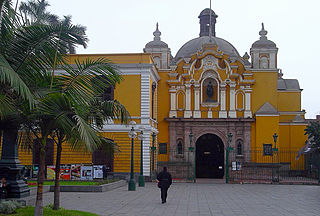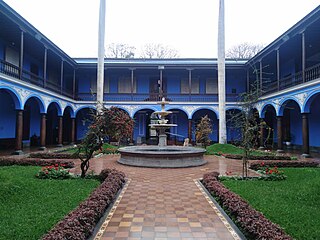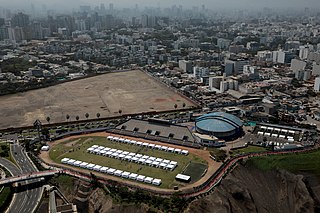
The National University of San Marcos is a public research university located in Lima, the capital of Peru. In the Americas, it is the first officially established and the oldest continuously operating university.

The Palacio de Torre Tagle is a building built during the colonial era of Peru that currently serves as the main headquarters of the Ministry of Foreign Affairs of Peru. It is located in the Jirón Ucayali in the historic center of Lima, two blocks southeast of the Plaza Mayor de Lima.

Barranco, founded in 1874 as San José de Surco, is one of 43 districts in Lima, Peru. Its current mayor is Jessica Vargas.

The Historic Centre of Lima is the historic city centre of the city of Lima, the capital of Peru. Located in the city's districts of Lima and Rímac, both in the Rímac Valley, it consists of two areas: the first is the Monumental Zone established by the Peruvian government in 1972, and the second one—contained within the first one—is the World Heritage Site established by UNESCO in 1988, whose buildings are marked with the organisation's black-and-white shield.

Arequipa, also known by its nicknames of Ciudad Blanca and León del Sur, is a city in Peru and the capital of the eponymous province and department. It is the seat of the Constitutional Court of Peru and often dubbed the "legal capital of Peru". It is the second most populated city in Peru, after the capital Lima, with an urban population of 1,296,278 inhabitants according to the 2017 national census.

The Plaza San Martín is one of the most representative public spaces of the city of Lima, Peru. It is located at the ninth block of Colmena avenue, within the Historic Centre of Lima which was declared a World Heritage Site in 1988 by UNESCO. It is located near the Plaza Mayor of Lima and is connected to it by the Jiron de la Union. Its central monument gives homage to Peru's liberator, José de San Martín.

The Park of the Exhibition, known between 1999 and 2004 as the Grand Park of Lima, is a park located in the neighbourhood of Santa Beatriz, itself part of the buffer zone of the historic centre of Lima, Peru. It was built to replace the city's walls, demolished as part of a citywide renovation project in order to host an international exhibition in 1872.

The Casona of the National University of San Marcos, also known as the Cultural Centre of San Marcos, which operates in the building, is a large Spanish colonial building that hosts the cultural centre of the National University of San Marcos, located in the Historic Centre of Lima, Peru. The building, as well as its adjacent public space, known as the University Park, is part of the area and of the list of buildings of the Historic Center of Lima that were recognized as a World Heritage Site by UNESCO, in 1988.

The UCV Clock Tower, also known by its Spanish name Torre del Reloj de la UCV, or Reloj de la UCV, is a monument made of prestressed concrete. It is by the Rectory Plaza of the Central University of Venezuela in the University City of Caracas, and was built between 1953 and 1954.

The Bicentennial of the Independence of Peru occurred on 28 July 2021. Its celebration commemorated 200 years since Peru's proclamation of Independence. The celebration consisted of a mix of local, state, and national activities that were planned since 2016. On 8 August 2016, the Prime Minister of Peru announced the creation of the Organizing Commission for the Commemoration of the Bicentennial of the Independence of Peru.

The Centennial of the Independence of Peru took place on July 28, 1921, as well as in December 9, 1924. To commemorate the hundred years of the country's independence from Spain, large and lavish parties supervised by President Augusto B. Leguía were held.

The Monument to Manco Cápac is a statue located in the homonymous square in La Victoria District, Lima, the work of the Peruvian sculptor David Lozano, inaugurated in 1926.

The Moorish Arch, also called the Friendship Arch or Spanish Arch, was a triumphal arch installed at the beginning of Leguía Avenue in Lima, Peru. It was made in a neo-Moorish style, inaugurated in 1924 as part of the Centennial of the Independence of Peru and demolished in 1939.

University Park is a public park located in the historic centre of the city of Lima, Peru. It is rectangular in shape and is located at the intersection of Abancay and Nicolás de Piérola avenues.

The Great Clock of Lima, also known as the Pedro Ruiz Gallo clock after its inventor, was a monumental clock created by Pedro Ruiz Gallo, and which was installed in the Parque de la Exposición in 1870 for the celebration of the Exhibition of 1872. The watch disappeared during the occupation of Lima by the Chilean Army in the War of the Pacific.

The Malecón de Miraflores is an esplanade in the coast of Lima, Peru. It's a major tourist attraction in the city.

The Real Convictorio de San Carlos, or Convictorio de San Carlos after independence, was a college in Lima created at the end of the Viceroyalty of Peru and which survived until the first decades of the Peruvian Republic.

Santa Beatriz is a neighbourhood in Lima District. It is the southernmost area of the district. It limits to the north, with the historic centre of Lima; to the east, with La Victoria; to the south, with Lince; and to the west, with Jesús María.

San Martín barracks, originally Junín barracks, was a military installation inaugurated in 1921 to house the Mounted Grenadiers Regiment of the Argentine delegation that visited the country for the Centennial of the Independence of Peru. Located the 13th block of the Avenida del Ejército, it was subsequently closed and auctioned in 2009 and demolished a year later.

The Clock Tower of Guayaquil, also known as the Moorish Tower, is a structure located in Guayaquil, Ecuador. It has gone through several incarnations before its current form, which ended construction in 1931.
























